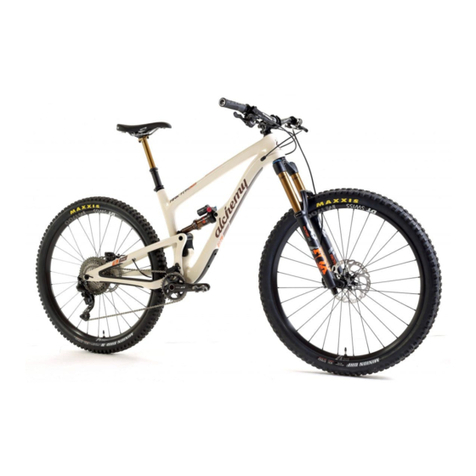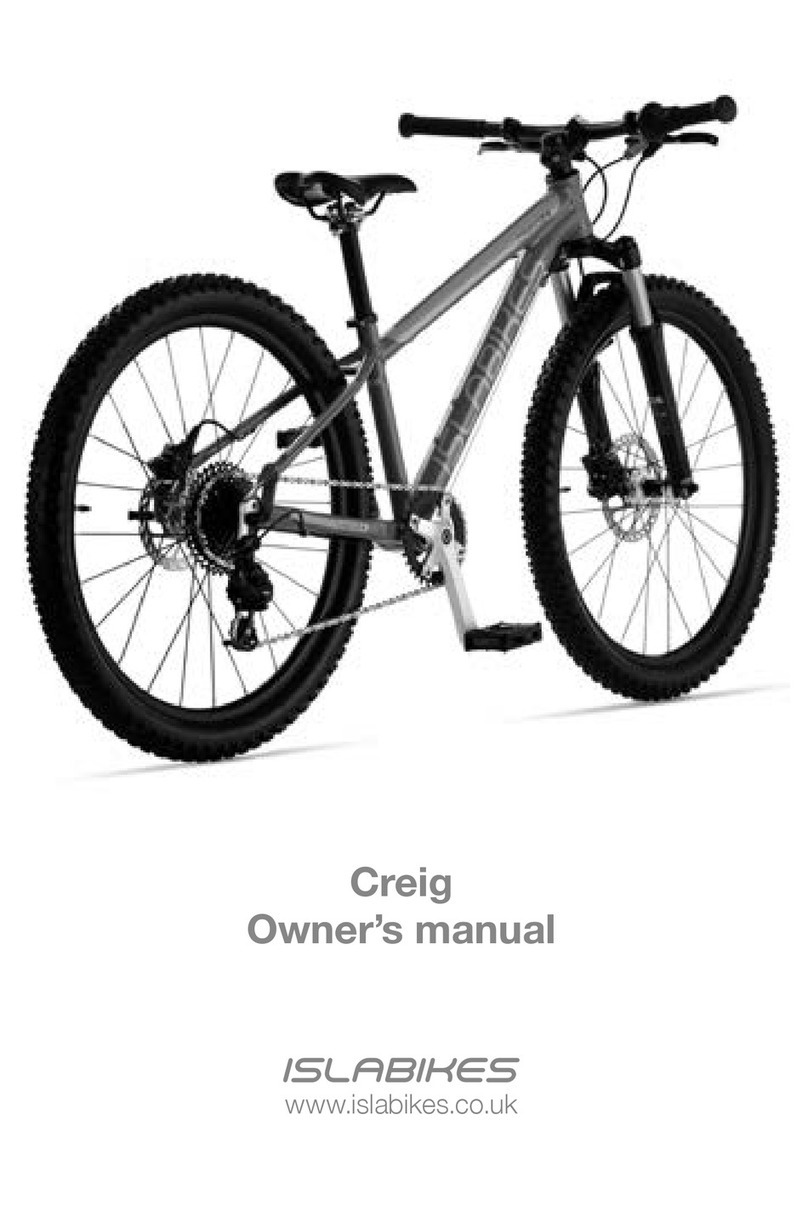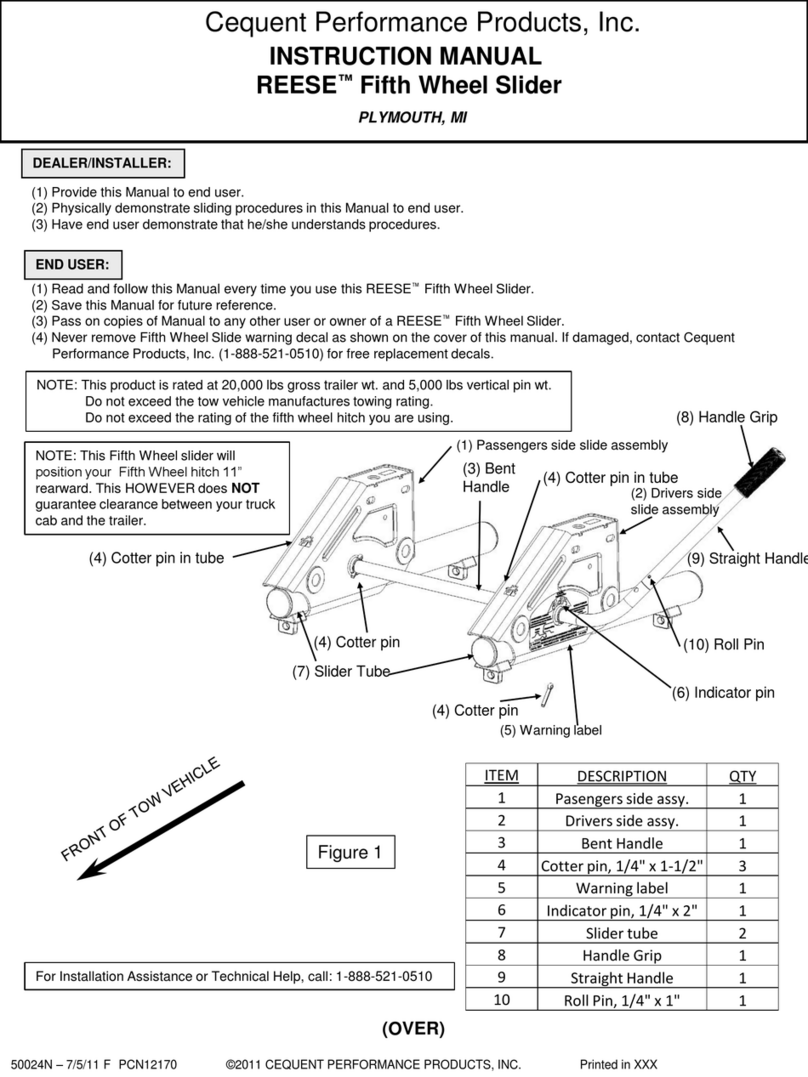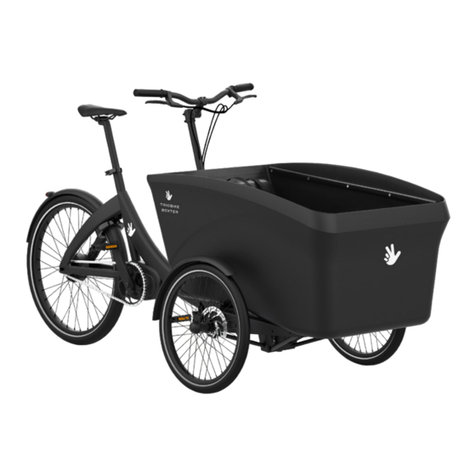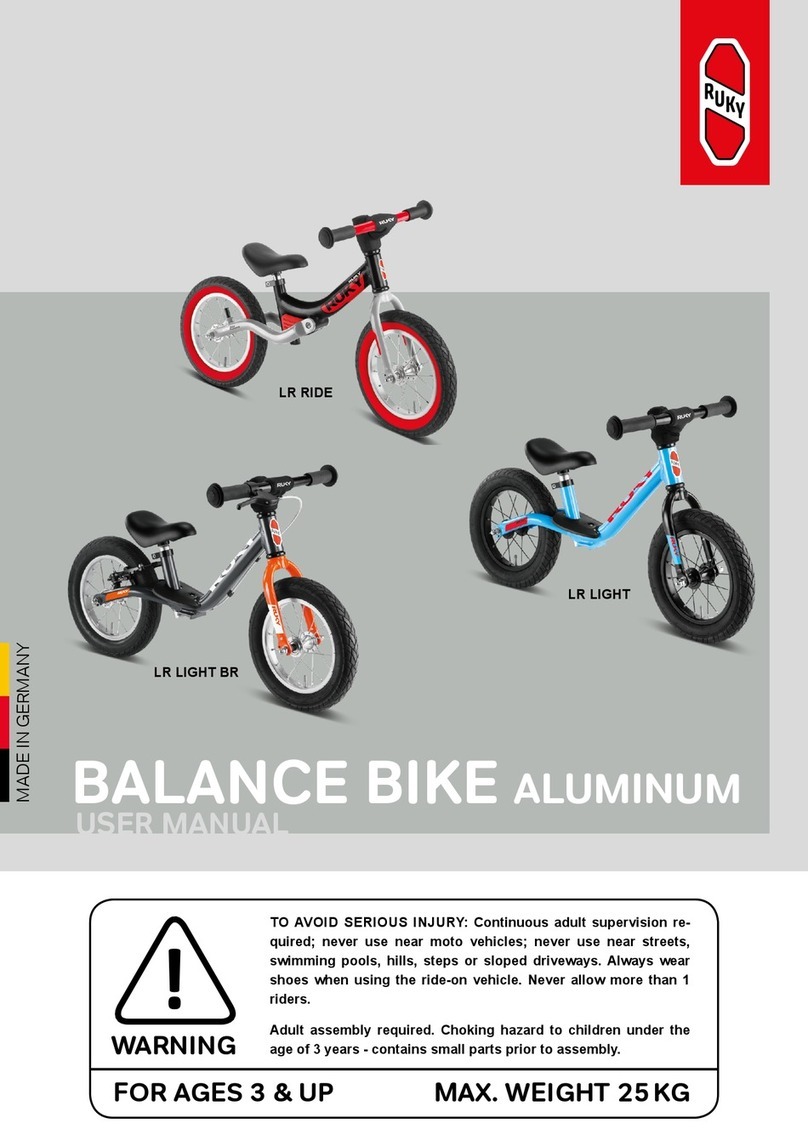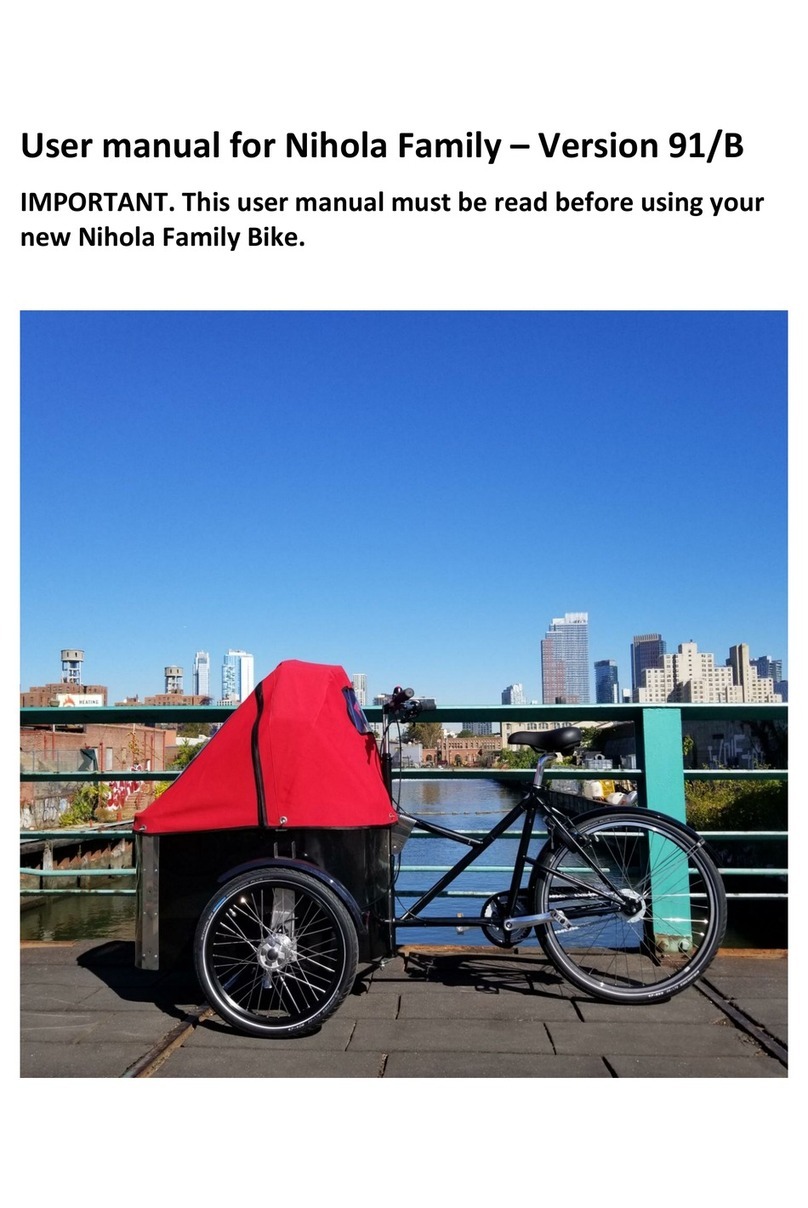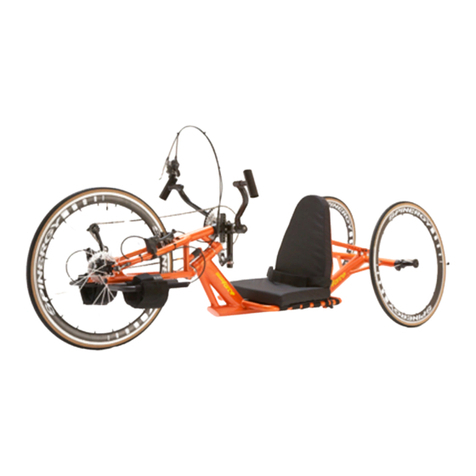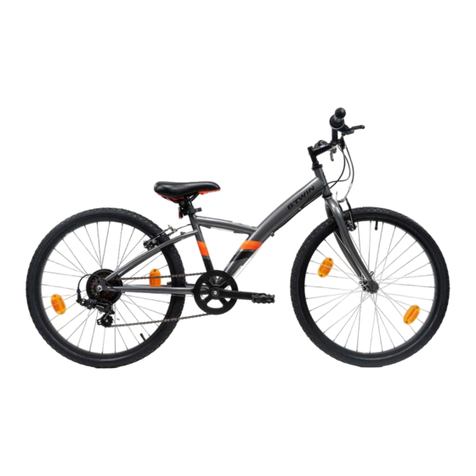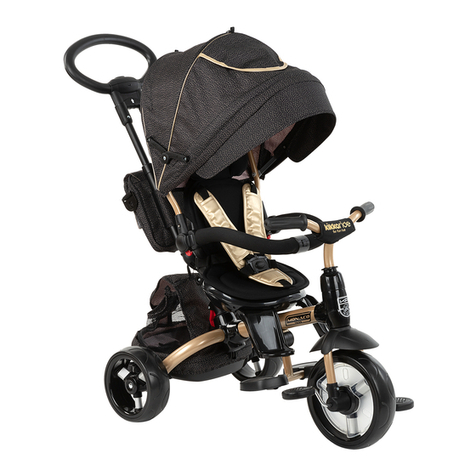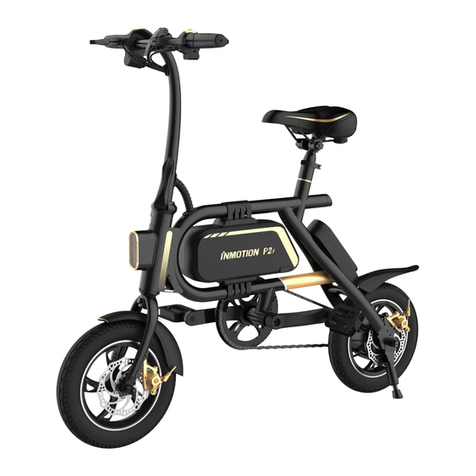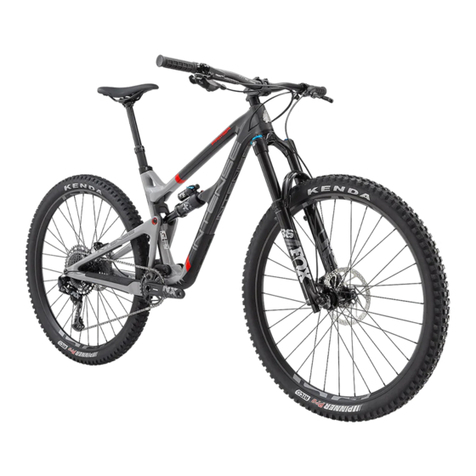Surface E250 User manual

1
SURFACE 604 E250/E350 BOAR OWNERS MANUAL

2
Thank you for purchasing a Surface604 Boar.
We welcome you to the exciting and revolutionary world of alternative transportation. Your high quality,
power on demand Surface604 bicycle
offers a new form of environmentally friendly transportation and
recreation. Throughout this Manual you will find useful tips and important
safety, performance and
maintenance information to ensure that you enjoy all the features Surface604 bicycles have to offer for
your riding enjoyment.
IMPORTANT: Please read this Manual before taking your first ride on your Surface604 bicycle. It is very
important to familiarize yourself with the product to ensure you experience the bike’s full performance
potential, all the while ensuring your safety and riding pleasure. We also recommend that you keep the
Manual on hand for future reference.
NOTE: It is important to understand that this is not a comprehensive use, repair or service Manual. Please
contact your local Surface604 dealer
for all service, repair and maintenance. Your local dealer will also be
able to refer you to additional books, DVDs, websites or cycling clinics/classes available in your community
to broaden your skills and knowledge in bicycle use, repair and maintenance.
ABOUT THIS MANUAL: The main purpose of producing this owner’s Manual is to ensure your safety at all
times while enjoying our
product. Along with many others in the cycling community, we constantly strive to
reduce possible risks associated with our products. We
also recognize the importance of you, the rider, to
clearly understand that with proper instruction of bicycle use and maintenance, the risk of
cycling-related accidents can be reduced. It is within this context we created the following Manual and invite
you to take responsibility to learn
about how to reduce inherent risks while bicycling and enjoying your
Surface604 bicycle. We also wrote the Manual to ensure readability and ease in
efficiently finding information.
We strongly recommend that you read the entire Manual and look for the WARNINGS or CAUTIONS we have
included throughout to alert you to potential risks of injury and/or damage.

3
>> CONTENTS
GENERAL WARNING.......................................................................................................................................5
ONE > BEFORE YOU RIDE ..............................................................................................................................6
BIKE FIT ...............................................................................................................................................................
6
SAFETY FIRST!...................................................................................................................................................
6
MECHANICAL SAFETY CHECK.............................................................................................................7
SOME ADDITIONAL PREPARATIONS ..............................................................................................................
9
FIRST RIDE .........................................................................................................................................................
9
OWNER’S MANUAL > ..................................................................................................................................10
TWO > SAFETY ..............................................................................................................................................11
THE BASICS ........................................................................................................................................ 11
RIDING SAFETY ..............................................................................................................................................
11
OFF ROAD SAFETY .........................................................................................................................................1
3
WET WEATHER RIDING...................................................................................................................................1
4
NIGHT RIDING ..................................................................................................................................................1
4
EFFICIENT RIDING TECHNIQUE.....................................................................................................................1
5
CHANGING COMPONENTS OR ADDING ACCESSORIES...........................................................................1
6
THREE > FIT ...................................................................................................................................................17
STANDOVER HEIGHT ......................................................................................................................................1
7
SURFACE604 FRAME FIT................................................................................................................................1
8
SADDLE POSITION..........................................................................................................................................1
8
HANDLEBAR HEIGHT AND ANGLE.....................................................................................................19
CONTROL POSITION ADJUSTMENTS................................................................................................20
BRAKE REACH.....................................................................................................................................20

4
FOUR > TECHNICAL INFORMATION ............................................................................................................21
WHEELS..............................................................................................................................................21
SEATPOST QUICK RELEASE ........................................................................................................................25
BRAKES.............................................................................................................................................. 26
SHIFTING GEARS...........................................................................................................................................27
PEDALS...............................................................................................................................................29
BICYCLE SUSPENSION ..................................................................................................................... 31
TIRES AND TUBES..........................................................................................................................................32
POWER ASSIST DRIVE SYSTEM...................................................................................................................34
FIVE > SERVICE.............................................................................................................................................35
SERVICE INTERVALS .....................................................................................................................................36
GETTING HOME WHEN SOMETHING BREAKS..........................................................................................37
IF YOUR BICYCLE SUSTAINS AN IMPACT...................................................................................................39
SIX > ABOUT YOUR SURFACE604 DEALER................................................................................................ 40
ACCESSORIES................................................................................................................................... 40
SEVEN > LIMITED WARRANTY ....................................................................................................................41
WARRANTY REGISTRATION..........................................................................................................................42
EIGHT > CONTROL PANEL DISPLAY ......................................................................................................43-53
INFO & SETUP..............................................................................................................................................43-53
NINE > MOTOR SPECIFICATIONS.................................................................................................................53
DETAILED SPECS.............................................................................................................................................53
TEN > BATTERY .......................................................................................................................................54-56
PRECAUTIONS & CARE...............................................................................................................................54-56

5
Like many forms of transportation and recreation, bicycling involves the potential risk of injury and/or damage. By choosing to cycle, you are
assuming responsibility for these risks. In an attempt to reduce the risk, we believe you need to know and practice the rules of safe and
responsible riding and of proper use and maintenance, which will help to reduce the risk of injury or damage. Consequently, you will find
many “WARNINGS” and “CAUTIONS” throughout this Manual followed by discussions on the consequences in failing to inspect and
maintain your bicycle and/or following safe cycling protocol. Again, we recommend you familiarize yourself with this information since we are
highlighting it with your safety in mind.
It is impossible to anticipate or discuss all situations or conditions in this Manual, which may or may not lead to injury or damage while
riding this bicycle. We have taken the utmost care and attention in manufacturing a safe and reliable product and in providing you with this
informative Manual that will assist you in reducing risks associated while using your bicycle. However, there are risks that cannot be
predicted or avoided, and consequently, are the sole responsibility of you, the rider. Our intention here is not to cast fear in riding a bicycle,
but instead to recognize the potential dangers associated with traveling on two wheels and thereby ensuring a safe and enjoyable
experience.
The combination of the safety alert symbol and the word WARNING indicates a potentially hazardous situation which, if not avoided,
could result in serious injury or death.
The combination of the safety alert symbol and the word CAUTION indicates a potentially hazardous situation which, if not avoided, may
result in minor or moderate injury, or is an alert against unsafe practices.
The word CAUTION used without the safety alert symbol indicates a situation which, if not avoided, could result in serious damage to the
bicycle or the voiding of your warranty.

6
ONE > BEFORE YOU RIDE
>> NOTE: As already strongly recommended, please
read this Manual in its entirety. Here we explain the
importance
of fitting the bike, safety and general
maintenance. Be sure
you understand each point in this
section before setting out
on your first ride. Refer to specific sections of the Manual
for
detailed content to ensure you are prepared and
ready for a
safe and enjoyable ride.
BIKE FIT
1 > The fit of your bicycle is extremely important. If the bicycle
is
too large or too small, this may pose a danger in causing
you to
lose control or fall. In addition, proper fit is essential for
maximum performance and comfort. To determine the right
size of bike that suits your body, go to Sections 3.1 and 3.2.
Your dealer will also be able to assist you in finding the right
size. When referring to size, bicycles are measured according
to the frame size. This number
signifies the size of the frame
and the overall size of the bike.
2 > With the right sized frame, you can now adjust accessories
to maximize safety, comfort and performance. Start with
determining whether your seat height is set correctly. To check
this and/or make
adjustments, go to Section 3.3.
3 > Now check to ensure the saddle is securely fastened to the
post (see Section 3.3) and the post clamp is secured (see
Section 4.2). A securely fastened saddle does not move in any
direction and a
secure post clamp prevents the post from
sliding up or down.
4 > Check to see if the handlebars and stem are set at the
right
height for you and are secure. To confirm, go to
Section 3.4.
5 > Now check the brakes. Squeeze the brake levers. Can you
operate them with ease? Do you see the front brake pads
grasping the disc when you squeeze the brake levers? It is also
a good idea
to lift your bicycle, spin each wheel, grasp the
brake and ensure
proper function. If the brake does not
function with ease have your
local dealer/mechanic adjust
them.
6 > Lastly, ensure that you fully understand how to operate your
new
Surface604 bicycle (see Section 4.9). Your new bicycle
offers features
unlike regular pedal operated bicycles. Contact
your local dealer to have any features or functions explained to
you before your first ride.
SAFETYFIRST!
1 > ALWAYS WEAR AN APPROVED HELMET WHEN RIDING
YOUR SURFACE604 BICYCLE. Please refer to your helmet
manufacturer’s
instructions for proper fit, use and care of the
helmet. Helmets are
availablefrom your dealer.
2 > Check to see that you have all required and
recommended
safety equipment for your first and future rides.
Also, be sure that
you know all laws pertaining to cycling in
your region. The laws
may include where you can cycle, the
use of hand signals or the
need for mandatory equipment
while cycling.
3 > Next, are your wheels securely fastened to the
frame/forks?
Wheels that are not safely secure can wobble
and impede the
bicycle performance or worse, dislodge while
riding and cause
injury or death. For your Surface604 bicycle,
the front wheel has a quick release mounting mechanism and
the rear wheel has a bolted mounted device. See Section 4.1
for an explanation on how to properly secure both types of
mounting devices.

7
4 > Now look at your pedals. Check to see that they are securely
fastened and the pedals spin freely.
5 > Your Surface604 bicycle comes equipped with a suspension
fork and
a suspension seat post. It is very important that you
understand how
the suspension works because it will influence
the performance and
handling of the bicycle. Either consult your
local dealer to explain or
read Section 4.6.
6 > Check to see if you have “toe-overlap” –this can occur with
smaller sized frames when your toe(s) make contact with the front
wheel when the wheel is turned and the pedal is in a forward
position. This can cause injury or harm to you and/or your bicycle.
If
you are rubbing the front wheel (or any other part of the bicycle
while
pedaling) see Section 4.5 or contact your local dealer before
you ride.
7 > Check to see that the lighting system is operating at peak
performance. To activate the lights, press the Mode button for
three
seconds and check the rear and front fixture for strong
light output. It may be helpful to roll your bike up to a wall and
turn the light on to see the output level and angle of the light.
Please refer to the lighting system manufacturer’s Manual for
more information about light
output and adjusting the fixture
angles for peak performance.
8 > Check to see that the battery is fully charged and operating
properly. Look for a full battery charge level on the command
console. If this is not the case, refer to Section 5.4 on charging
your
battery. Always make sure your battery container is well
fastened to the frame and locked.
MECHANICAL SAFETY CHECK
Always do a complete check of the condition of your bike
before every ride. We also recommend regular maintenance
of your bicycle to prolong the life of the components and
maximize safety.
✔Nuts, Bolts and Straps: Ensure all are secure. An easy
way
to test for this is to lift the front wheel off the ground
by two or
three inches and then drop the wheel. Listen,
watch and feel for anything loose. Do the same for the
rear wheel. Next, do a
quick visual and tactile inspection
of the entire bicycle. If you find
something loose, tighten it
before your ride. This is a good habit
to develop before
each ride. Lastly, if you do discover something you are not
sure about, please consult your local dealer to ensure
all is
safe.
✔Tires and Wheels: Make sure your tires have the correct
amount of air pressure. Tires with too little or too much air
pressure can impede performance and be unsafe while riding
your bike. To ensure your tires are at the necessary air
pressure
(or psi), there are two steps you can follow. First, if
you have a tire
gauge, apply it to the tire valve and check the
psi. Much like a tire
on a car, the recommended psi is
stamped on the sidewall of the
bicycle tire. When you are
sure the tire is set to the correct psi, squeeze the tire to
familiarize yourself with how the tire should
feel to your hand.
With your tires ready to roll, slowly spin each
wheel and watch
for any cuts in the tread and sidewall, or road
debris lodged in
the tire such as wood, glass or nails. Remove
any debris and
ALWAYS replace any tires with cuts or visual
damage before
you ride. Lastly, check to ensure your wheel (or
rim) spins
straight or “true”–this means that when you spin the
wheel, it
does not wobble side to side or rub against your brake
pads.
If you find your wheel wobbles side to side or rubs against

8
the brake pad even slightly, take your bicycle to your local
bicycle
mechanic to have the wheel trued.
CAUTION: For your brakes to work effectively, the
wheel
(or rim) must be “true.” Do not attempt to true a
wheel unless
you have the knowledge, tools and
experience. Truing the
wheel is better left to your local
bicycle mechanic to ensure
your wheel performs properly
and safely.
✔Brakes: Check to see the brakes are working correctly
(see
Section 4.3). Squeeze the brake levers for both front
and rear
brakes and look to see if the front wheel quick-
release lever is closed, all control cables are seated and
securely engaged, and
that the brake discs are intact.
Also, check that the brake levers, when fully squeezed, do
not touch the handle-bar. If you find a
problem, DO NOT
RIDE THE BICYCLE and take the bicycle to your local
dealer for service.
✔Quick Release: Check to see the front wheel and seat post
quick-release mounts are properly adjusted and securely
fastened. (see Sections 4.1.1 and 4.2, respectively)
✔Handlebar and Saddle Adjustment: Check to see the
handlebar stem and suspension seat post are properly aligned
and securely fastened. Make sure the handlebar stem and
suspension seat post are parallel with the bicycle’s “centre
line”
(imagine a straight line that runs from the rear tire to the
front tire). Also, ensure the stem and post are clamped
securely so that
neither can be twisted or moved.
✔Handlebar Ends: Check to see the handlebar grips are secure
and in good condition.
WARNING: Loose or damaged handlebar grips
can cause you to lose control of the bicycle and fall.
Unplugged handlebar ends can cut your body (handlebar ends
are often cut when the bicycle is assembled and may not be
filed to remove sharp edges or spurs) and can cause serious
injury in an otherwise minor accident.
✔Bicycle Suspension: For your seat post suspension, check
the
rail clamp plate screw for proper torque and that the seat
post
quick-release is properly tightened (see Section 4.6 for
more details). For the front suspension fork, ensure that it is set
correctly for the terrain you have chosen for your ride.
✔Battery Container: Ensure the battery container is locked in
place and connected; check by depressing the mode button on
the command console to confirm digital control activation.

9
SOME ADDITIONAL PREPARATIONS
Here are some additional preparations we recommend to help in
ensuring you have a safe and comfortable ride:
✔Carry a good quality hand pump, patch kit, spare tube and
know how to repair a tire (see Section 5.2 and Section 4.7). Take
a bicycle maintenance/repair course or access the many books/
DVDs that your Surface604 dealer can recommend.
✔Carry sufficient water (e.g., water bottles, water bladders, etc.)
and food to ensure your body is properly fueled. Although your
bicycle is equipped with power on demand, your body is also a
contributing engine –no fuel, no go!
✔Dress appropriately. Wear form fitting yet comfortable clothing
designed for cycling. A good pair of shorts, jacket, gloves and
glasses will ease wear and tear of long and short rides (see
Sections 2.1 (#5), 2.4 and 2.5 for more information).
✔As with any activity in life, take a good attitude. Relax and enjoy
your ride –there is no hurry. Ride according to your athletic
ability but also know you have power on demand to assist you.
FIRST RIDE
It is time for your first ride. Before you strap on your helmet and
prepare to ride, take a moment to choose a location that is a
controlled environment to allow time to familiarize yourself with
the
controls, features and performance of your bike. The location should
be clear of cars, other cyclists, obstacles or other hazards.
Be sure to familiarize yourself with the braking system of the bike
(see Section 4.3). Start with riding at a slow speed and test the
brakes. Put your weight toward the rear and gently apply the rear
brakes first before engaging the front brakes. Sudden or excessive
application of the front brakes can cause your body to lunge
forward
and could pitch you over the handlebars. Applying brakes
too hard
at anytime when riding can lock up a wheel, which can
cause you to
lose control and fall.
If your bicycle has clipless pedals, be sure to practice getting in
and out of them (see Section 4.5).
Your bicycle comes equipped with a suspension seat post and
front fork
suspension. Familiarize yourself with how the suspension
systems
respond to brake application and rider weight shifts (see
Section 4.6).
Next, practice shifting the gears (see Section 4.4) while pedaling -
do not
attempt to shift gears when not pedaling. Also, remember
not to shift
gears when pedaling backwards or pedal backwards
after shifting
gears. This could jam the chain and cause serious
damage to the bicycle
and drivetrain.
Familiarize yourself with the power assist drive system (see
Section
4.9) in order to safely enjoy this feature. Take time to be comfortable
with the command console.
Finally, familiarize yourself with the overall handling and response of
the bike and ensure you are comfortable while riding the bicycle.
If you haveany questions, please contact your local
Surface604
dealer for assistance. See Section 6.1 for contact
information.

10
OWNER’S RECORD
Please fill out the following Warranty Registration for your records and mail a copy of the Warranty Card to Surface604, or register on-line.
First name:
Last name:
Address:
City:
State/Province:
ZIP/postal code:
Country:
Phone: ( )
Email:
Model:
Serial number:
Date of sale(MM/DD/YY):
Dealer name:
Notes:

11
TWO > SAFETY
THEBASICS
1 > Always wear a bicycling helmet that
meets
the latest certification standards and
follow the
helmet manufacturer’s
instructions for proper
fit, use and care of
your helmet. Most serious
bicycle injuries
involve head injuries, which
may have been
avoided if the rider had worn a helmet
.
Fig 2.1
WARNING: Failure to wear your helmet when
riding a bicycle may result in serious injury or death.
2 > Always do the Mechanical Safety Check before you get
on
your bike (see Section 1.3).
3 > Be competent in operating the controls on your bicycle:
brakes (see Section 4.3); pedals (see Section 4.5), shifting
(see
Section 4.4) and power assist drive system (see
Section 4.9).
4 > Be careful to keep body parts, clothing and other
objects
clear from the sharp teeth of the chainrings, the
moving chain, the turning pedals and cranks, and the
spinning wheels of your
bicycle.
5 > Always wear:
✔Shoes that fit your feet properly and grip the pedal securely.
Do not ride your bicycle barefoot or with loose fitting shoes
such as sandals.
✔Appropriate cycling clothing that is bright, visible and fit snugly
to your body. Loose clothing can tangle in your drivetrain or
wheel or
be snagged by objects at the side of the road or trail.
✔Protective eyewear to protect against airborne dirt, dust and
bugs. Also, if it is sunny, wear tinted lenses and, depending on
your riding preference, clear, yellow or orange lenses when not.
6 > Do not jump with your Surface604 bike. Jumping a bike can
be fun, but
it puts you and your bike at risk of serious harm.
Jumping causes
stress on everything from the spokes to your
pedals, and if you lose
control, you can cause serious injury or
death. If you insist on jumping your bicycle, understand that you
are doing this at your own risk.
7 > Ride your bicycle at a speed that is appropriate for the
conditions in which you are riding.
RIDING SAFETY
1 > Observe all local bicycle laws and regulations. Pertinent
laws
include, but are not limited to, helmet laws, child
carrier laws
and special bicycle traffic laws. Important
regulations include,
but are not limited to, licensing of
bicycles, riding on sidewalks, and regulations concerning
bike path and trail use. It is your
responsibility to learn and
obey all laws and all regulations that
pertain to cycling in
your area.
2 > Always respect the rights of other road or path users such
as
motorists, pedestrians and other cyclists.
3 > Ride defensively. Always assume that others do not see
you. Never underestimate the unpredictability and risks
associated with
road riding.

12
4 > Some helpful defensive habits include looking ahead to avoid:
•
Vehicles slowing or turning, entering the road or your lane
ahead of
you, or coming up behind you.
•
Parked car door opening –it is a good habit to scan parked
cars
for people in the driver seat to alert you to the possibility
of a door
opening.
•
Pedestrians stepping out
•
Children or pets playing near the road
•
Hazardous road conditions: pot holes, gravel, sewer grates,
expansion joints, road or sidewalk construction, debris and
other
obstructions that could cause you to swerve into traffic,
catch your
wheel or otherwise cause you to lose control and
have an accident. The many other hazards and distractions,
which can occur on a bicycle ride.
5 > Whenever possible, ride within designated bike lanes, on
designated bike paths or if riding on the road, ride as close to the
edge as possible. If you feel uncomfortable with the riding
conditions
(e.g., road with very narrow shoulder or no shoulder at
all) seek out
alternative routes that are safe.
6 > Obey all traffic laws. Stop at all stop signs and traffic lights
and slow down to look both ways before proceeding through all
intersections regardless of whether you have the right of way or
not. Remember that a collision with a vehicle, whether the
driver’s fault or
not, will likely cause you much more harm than
the vehicle.
7 > Learn and use hand signals to let other users on the road
know where you are turning or changing your position while on
the road.
8 > Never ride with headphones. They may mask important
traffic
sounds and emergency vehicle sirens. The
headphones, or the sounds they are amplifying may distract
you from concentrating on
what is happening around you.
9 > Never hitch a ride from vehicles or other cyclists.
10 > Never ride your bicycle while under the influence of alcohol
or drugs.
11 > Observe and yield the right of way at all times, especially
for
vehicles.
12 > Always respect the road –do not weave in and out of traffic
or
make any sudden moves that may surprise other people with
whom you are sharing the road.
13 > Do not perform jumps, stunts or wheelies -- they can cause
you to lose control of your bicycle and result in injury or death
and/or
damage to your bicycle.
14 > Never carry a passenger unless it is a small child wearing a
certified bicycle helmet and who is secure in a certified and
correctly
mounted child carrier or a child-carrying trailer.
15 > Never wear or carry anything that obstructs your vision
or impairs complete control of your bike or which can
become
entangled in the moving parts of your bicycle.
16 > Whenever possible, avoid riding your bike in conditions
with poor visibility or are hazardous, such as in bad weather,
riding at dusk or in the dark, or when you are extremely tired.
Each of these
conditions increases the risk of an accident.
17 > Your new Surface604 bicycle purchase will inevitably create
much
excitement and the opportunity to ride with other people
can also be exhilarating. Do not get so carried away that you
forget safety
precautions, traffic laws and common sense –
always ride safely and
defensively to enjoy many more rides to
come!

13
OFFROADSAFETY
1 > Just as in road riding, never underestimate the
unpredictability
and risks associated with off-road riding. The
variable conditions
and hazards of off-road riding demand close
attention and specific
skills. If you are riding off-road for the first
time, consider riding with others with experience or, if available,
take an off-road riding course in your community. Ask your local
dealer for information. Regardless, start slowly and choose a
relatively flat and easy terrain to build up
your skills and
confidence. Your Surface604 bicycle comes equipped with front
suspension and a seatpost, which will take some time to get
used to as the suspension does soften the ride and may allow
you to experience increased speeds. The increased speed may
cause you
to lose control of your bicycle and fall. Get to know
how to handle
your bike safely before increasing speeds or
advanced terrain.
2 > Always wear appropriate safety gear required for the type
of
riding you are doing (see Sections 2.4 and 2.5). Ask your
dealer for
more information.
3 > Do not perform jumps, stunts or wheelies -- they can cause
you
to lose control of your bicycle and result in injury or death
and/or
damage to your bicycle.
4 > Never ride alone when in remote areas. Even if riding with
other people, always ensure someone (e.g., friend, family
member, co-worker) knows where you are and when to expect
your return.
5 > Ensure you ride on trails designated for or permit bicycling.
Learn
and obey all laws regulating how and where you can ride
off-road. Always respect private property, which can be difficult to
know in
remote areas.
6 > Be respectful of the rights of other trail users –motorists,
pedestrians, equestrians and other cyclists.
7 > Yield right of way to pedestrians and animals. Always
ride in
a way that does not startle, surprise or endanger
them. Stay far enough away so that their unexpected moves
do not endanger you. Communicate with the person or
animal before approaching to alert
them of your presence,
to reduce the chance of startling them.
8 > Always stay on the designated trail and respect the natural
environment. Do not contribute to erosion by riding in mud or
with unnecessary sliding or skidding. Avoid locking the wheels
as much
as possible to prevent skidding and additional erosion.
Do not
disturb the ecosystem by cutting your own trail or
shortcut through
vegetation or streams. It is your responsibility
to minimize your
impact on the environment. Always leave the
natural environment
as you find it and always take out
everything (e.g., food wrappers, accessories) you brought in.
9 > BE PREPARED. Ensure you have adequate food/water,
appropriate clothing for a range of weather conditions and
essential tools.

14
WET WEATHER RIDING
WARNING: Wet weather impairs traction, braking
performance and visibility for you and your bicycle and
other motorists or cyclists on the road. The risk of an
accident is dramatically increased while riding in wet weather.
Wet weather can make it harder to control your bicycle and
easier
to lose control. Wet conditions can dramatically reduce
the stopping power of your braking system (and for those of
other vehicles or
cyclists on the road). In addition, your tires will
not grip as well as in
drier conditions, which can impair braking.
Exercise extra caution
and safety when riding in wet weather by
riding more slowly and
applying your brakes earlier and more
gradually than you would in
drier conditions. Comfort while riding
your bike in wet weather can also be impaired. Fortunately, there
is a range of clothing available to help keep
you warm and dry,
which will benefit you in terms of conserving energy and
ensuring you can remain focused on the road. Dress
appropriately for the weather conditions in which you are riding.
Check with your local dealer for a selection of clothing options
and accessories.
NIGHT RIDING
Riding a bicycle at night is many times more dangerous than
riding during daylight hours. It can be more difficult for
motorists and pedestrians to see you while riding your bicycle
at night. Your Surface604 bicycle does come equipped with a
quality lighting system to increase your visibility by motorists
and pedestrians and to improve
your vision as you ride.
However, a lighting system does not provide
the same amount
of light as daylight and therefore we remind you to ride at your
own risk. We do advise that children should never ride at
dawn, at dusk or at night and adults ride at their own
discretion.
WARNING: Please remember that riding at dusk,
dawn, at night or in conditions of poor visibility, without
your lighting system operating properly is dangerous and
may result in serious injury or death.
WARNING: Check to see that your lighting
system is operating properly and that the fixtures (front
and back) are clean, straight, unbroken and securely
mounted. Have your local dealer replace or repair damaged
fixtures and straighten or tighten any that are bent or loose.
Your dealer can also assist you in repairing any problems with
the lighting system overall. It is a very good habit to regularly
check to see that your lighting system is operating at peak
performance.

15
If you choose to ride under conditions of poor visibility, always
check to ensure you comply with local laws pertaining to riding a
bicycle
at night and take the following strongly recommended
additional
precautions:
•
Make sure your bicycle’s lighting system is operating
properly, is
correctly positioned and securely mounted (see
Section 4.8)
•
Always wear reflective and brightly colored clothing and
accessories such as reflective vest, reflective arm and leg
bands, and reflective strips on your helmet*. Any reflective
device and
bright lighting systems will help attract attention
from motorist, pedestrians or other cyclists on the road.
•
Ensure that none of your clothing or accessories are
obstructing light fixtures or reflective pieces.
* Note: Please check your certified helmet manufacturer’s
warranty
details to ensure that adding a reflective strip does
not void the
warranty before attaching anything to your helmet.
If in doubt, contact your local dealer for assistance.
While riding at dusk, dawn or in conditions of poor visibility, ride
safely and cautiously. Avoid dark areas or areas with heavy or
fast-
moving traffic. Avoid road hazards and if possible, ride on
familiar
routes. If this is not possible, try to find well-lit routes
with minimal
traffic.
EFFICIENT RIDING TECHNIQUE
Enjoying your ride is directly associated with ensuring you
have sufficient energy throughout the duration of your ride. It is
important to learn to ride efficiently. You may have noticed that
experienced bicycle riders look smooth and relaxed as they
pedal, legs turning circles, almost flowing, which is a good
indicator that
they are using their energy efficiently. By riding
smoothly, you will
have more energy and better control of your
bike. Here are some
tips to keep in mind or even visualize while
riding:
•
Both on-road and off-road riders need to strive to keep their
upper
body relaxed and relatively free of movement (e.g.,
hips should
not be rocking side to side) except if you
dismount or stand on
the pedals to climb a hill.
•
Remain on your seat as much as possible –standing on the
pedals can burn more energy than while remaining mounted
on
the saddle.
•
Remember to breathe! Learn proper breathing techniques
when
riding hard or climbing hills to help keep your muscles
fresh and
your mind focused.
Your Surface604 bicycle comes equipped with an intelligent
energy
management system that helps you maximize your
riding efficiency
(see Section 4.9).
Your bike must be fitted correctly to your body. With a properly
fitted bike, you can then focus on your posture and pedal
techniques to develop a smooth, brisk, confident, and round
pedaling stroke.

16
When practicing efficient cadence, concentrate and visualize
pedaling smooth, flowing circles - not squares. An efficient
pedal
stroke flows through one complete revolution. Most
riders will find
that their ideal cadence is around 90 revolutions
per minute (rpm), although it may be as low as 75 rpm. By
developing a basic bicycling technique from these tips, you will
be able to ensure efficient energy output when riding your
Surface604 bike.
You may also want to contact your local dealer for
additional
resources or courses available in your
community.
CHANGING COMPONENTS OR ADDING
ACCESSORIES
There are a range of components and accessories available
on
the market to enhance the comfort, performance and
appearance
of your Surface604 bicycle. Please know that if
you choose to change
components or add accessories on
your bicycle, you are doing so at your own risk. We are
unable to test that all components or accessories available on
the market are compatible, reliable or safe
on your Surface604
bicycle. Before installing any component or accessory, please
consult your local dealer to ensure that it is compatible with
your bike.
WARNING: Failure to confirm compatibility
or
to properly install and maintain any component
or
accessory can result in serious injury or death or
damage to your bicycle.
WARNING: Changing components or accessories
on your bicycle may void the warranty. Please refer to your
warranty and check with your local dealer before making any
changes to your bicycle.

17
THREE > FIT
>> NOTE: Correct fit and properly adjusted components
are
essential for maximum performance, safety and
comfort
while riding your Surface604 bicycle. Your dealer
can assist in
ensuring you have the right sized frame.
Making adjustments
to your bicycle to ensure the correct
fit for your body
and riding conditions requires appropriate skills, special
tools and experience. Always have your dealer make the
adjustments on your bicycle. If you have the necessary
skills, tools and experience and prefer to make the
adjustments
yourself, have your dealer check your work
before riding.
Ensure you have a Surface604 bicycle that ‘fits’you properly.
This means
that the frame is the right size and the
components/parts are
Fig
3.1
top tube. Instead, you can
follow the same protocol as
with other bikes but use
the
top of the battery
container
as your guide.
Therefore, to check for
correct stand over
height,
straddle the bike
while
wearing the kind of
shoes
in which you’ll be
riding and
bounce vigorously
on your
heels. If your crotch
touches the top of the
battery container, the
frame
is too big for you.
A bike which you ride
adjusted to your preference. A bike that is too big, too small
and/or
not set up properly is harder to control and can make for
an uncomfortable ride.
WARNING: If your bicycle does not fit properly,
you may lose control and fall.
STANDOVERHEIGHT
Stand over height is the basic element of the bike fit (see Fig
3.1). For most bikes, it is the distance from the ground to the
top of the
bicycle’s frame at that point where your crotch would
be if you
were straddling the bike and standing half way
between the saddle
and the handlebars. However, your
Surface604 frame does not have a
Paved surfaces and never take off-road should give you a
minimum
stand over height clearance of 7 centimeters (2.8 inches). A
bike
that you’ll ride on unpaved surfaces should give you a
minimum of
10 Centimeters (4 inches) of stand over clearance.
>> NOTE:
If in doubt, have your dealer assist you in finding the
ideal frame for your size and riding style.

18
SURFACE604 FRAME FIT
As your Surface604 bicycle does not have a top tube you may
also use the
seat tube measurement to determine proper fit. The
seat tube length designation is measured as the length from the
middle of the bottom bracket to the top of the seat tube. For
example, if you rode a 19’’
bicycle in the past, you may also
consider a 19” Surface604 frame.
1 > Up and down adjustments. To check for the correct saddle
height
•
Sit on the saddle;
•
Place one heel on a pedal;
•
Rotate the crank until the pedal with your heel on it is in the
down
position and the crank arm is parallel to the seat tube.
>> NOTE: Have your dealer assist you in finding the ideal
frame
for your size, riding style and experience.
SADDLE POSITION
Evaluation: if your leg is not completely
straight (but not locked) and just
touching the centre of the pedal, your
saddle needs
to be adjusted. If your
hips have to rock for the heel to reach
the pedal, the saddle
is too high. If your
knees are obviously
bent with your heel
on the pedal, your
Minimum
insertion line
It is very important that
your saddle position is set
according to your personal
preference to ensure
maximum performance
and
comfort while riding
your
bike. If you find that
the
saddle is not
comfortable, ask your
dealer to assist you
in
making any adjustments.
He/she will have the
necessary tools and skills
required for the
adjustment. The saddle
can be adjusted
in three
directions:
saddle is too low. When you have
ensured
the saddle is set to the correct
height,
make sure that the seat post does not exceed the minimum
insertion
or maximum extension (see Fig 3.3b). There will be a
line or marking on the seat post indicating the point at which you
cannot extend the
post before it is unsafe.
WARNING: A mounted seat post that exceeds the
allowable Minimum Insertion or Maximum Extension
mark (see Fig 3.3b) can cause injury and/or for you to
lose
control of your bike and/or damage your bicycle.

19
2 > Front and back adjustments. The saddle can be adjusted
forward or back to ensure you get optimal position for
performance
and comfort. Ask your dealer to set the saddle for
your optimal riding position and to show you how to make any
adjustments.
3 > Saddle angle adjustments. The saddle angle can be
adjusted
either up or down. Most riders prefer a horizontal
saddle, but some also like the saddle angle adjusted slightly up
or down. Your dealer can make any adjustments for you and/or
teach you to do it yourself. If you do make adjustments,
remember that small changes to the saddle angle can have a
substantial effect on the bicycle’s performance and your
comfort. Therefore, make small adjustments to the saddle for
one direction at a time. Ride the bicycle in a safe environment to
evaluate performance and comfort before making any further
adjustments.
WARNING: Be sure to double check that you have
securely tightened the saddle adjusting mechanism after
each adjustment before riding. A loose saddle clamp can
cause damage to your bicycle and/or cause you to lose control
of the bicycle and fall. When the saddle is securely tightened,
there is no saddle movement in any direction. It is a good habit
to periodically check the saddle for movement before riding the
bicycle. This is done easily and quickly by grabbing the saddle
and trying to move it in different directions.
WARNING: Some people have claimed that
extended riding with a saddle that is not adjusted
correctly or that does not support your pelvic area
correctly can cause short-term or long-term injury to
your nerves and blood vessels, or even cause impotence.
If your saddle causes you pain, numbness or discomfort, see
your dealer as soon as possible to ensure the saddle model
and/or adjustments are correct for your body and riding style.
HANDLEBARHEIGHT AND ANGLE
Your Surface604 bicycle comes equipped with an adjustable
stem. We
recommend that you contact your local dealer for
assistance in
making any adjustments to the stem. Your
Surface604 dealer can help
you with any adjustments to the
handlebar height and angle.
WARNING: The stem’s Minimum Insertion Mark
must not be visible above the top of the headset. If you
see that the Minimum Insertion Mark is visible, have your local
dealer make the necessary adjustments. A stem that exceeds
the Minimum Insertion Mark may break or damage the fork’s
steering tube, which can cause you to lose control and fall.

20
WARNING: If the stem binder bolt, handlebar
binder bolt or bar and extension clamping bolt are not
securely tightened, you could lose control of your bicycle
and fall and/or damage your bicycle. To quickly check to
ensure bolts are secure, place the front wheel between your
legs and attempt to twist the handlebar/assembly. If you can
twist the stem in relation to the front wheel, turn the handlebars
in relation to the stem, or turn the bar and extensions in relation
to the handlebar, the bolts are not fastened properly. Either
fasten them yourself or see your dealer for help. Do not ride
your bicycle until you are sure all bolts are securely fastened.
CONTROL POSITION ADJUSTMENTS
The positioning and angle of the control mechanisms (e.g.,
brake levers, derailleur adjustors, and command console) on
your handlebars can be adjusted. Ask your dealer to make
any
adjustments to suit your preference.
BRAKEREACH
The brake levers can be adjusted for optimal reach; however, we
do not recommend that you attempt to adjust them yourself
because
your hydraulic disc braking system is fluid filled. If you
have small
hands or find it difficult to squeeze your brake levers,
ask your local
dealer to assist you in making an adjustment or
replace the levers
with ones that suit your needs or preferences.
WARNING: The shorter the brake lever reach, the
more critical it is to have correctly adjusted brakes, so
that full breaking power can be applied within available
brake lever travel. Insufficient brake lever travel can result in
serious injury or death.
This manual suits for next models
1
Table of contents
